More on IMAC Chiropractic “Stem Cell” Clinic Fundraising
As you may know, I often write about what I experience on a day-to-day basis. Last night, I got an unsolicited e-mail from a physician whom I respect about IMAC. This is the chiro stem cell clinic group that is trying to raise money in the public stock markets to expand nationwide. There was an investor presentation attached, so let’s dive into that document this morning. I will review it from the standpoint of a potential investor.
Who Is IMAC?
IMAC is a chiropractic clinic chain that has added stem cell therapy, like many across the U.S. The acronym IMAC stands for “Integrated Medical and Chiropractic.” The group has hopes to expand out of the Midwest and open many more clinics nationally. According to their investment documents, they also hope to establish their own brand of umbilical cord blood as well as, at some point, try to approach employers to get insurance coverage for their services.
[2/3/19—Note, I received word after this piece published that despite the acronym IMAC standing for “Integrated Medical and Chiropractic” in the December 14, 2018 investor slide deck (slide 9) and the December Investor Prospectus (page 9/223), IMAC now lists on its website under “About Us” that the acronym stands for “Innovative Medical Advancements & Care.”]
My History Blogging About IMAC
My first attempt to find out more about this group was late last year. That was prompted by a strange interaction with their chief scientific officer on LinkedIn as well as getting sent their written investment documents. What did I find back then?
In my opinion, IMAC was like many other chiropractic “stem cell” clinic chains. They overused midlevel providers, and while they had medical doctors employed at some clinics, these physicians were not experts in the field of regenerative orthopedics. In addition, their investment prospectus exaggerated a few things. They also had no clinical data collected or published. After performing a deep dive on the clinic, I had to conclude that if I had a patient in the area, I would not refer that patient to this clinic chain. Now, strangely enough, a doctor who has a clinical practice close to IMAC and to whom I would refer patients has reached out with an unsolicited e-mail about IMAC.
Yet Another E-mail
Since my blog, I have gotten several unsolicited e-mails about IMAC. The one I received yesterday was interesting as it was from a local provider who is experienced in regenerative orthopedic care and whom I respect as a colleague. Meaning, despite this physician not being part of the Regenexx network, if my brother or sister lived close to this doctor, I would refer them to this clinic for care. Given that I had already concluded that I would not refer patients to IMAC, this sets up an interesting juxtaposition. Why? Because this provider is local to some IMAC clinics and, as such, would know more about the day-to-day workings of the clinic chain.
Would a Regenerative Medicine Expert Invest?
I know quite a bit about regenerative medicine and orthopedics. I was the first physician on earth to perform a bevy of orthopedic injection procedures using stem cells. I’ve published more than 25 peer-reviewed research papers on the topic. I’ve authored many book chapters, educated many fellows, and am the chief medical officer of the world’s largest physician network focused on regenerative orthopedic care. I have treated many thousands of orthopedic patients with PRP and stem cells and hold many patents on the topic. So if I take a long hard look at an investment in regenerative orthopedic care, I’m looking at this from the standpoint of significant experience.
So what’s the first thing I would do to vet this investment? Before looking at any documents, as a practicing doctor, I would make phone calls or send e-mails to the local doctors in the area whom I respect. While on the one hand, doctors in the same area are often competitors and oftentimes don’t like their competition, on the other, they also get a sense of the quality of that competition. So how does the local regen med expert I contacted view the IMAC clinics? (I will paraphrase):
- They overpromise and underdeliver.
- They sell pricey packages of care that include chiropractic and PRP/stem cell injections and promise unrealistically high success rates.
- Their physicians generally don’t have much expertise or training in regenerative medicine (compared to this expert).
- This physician sees many patients from IMAC clinics after their care has failed there and who should have never been offered a regenerative medicine injection procedure.
The interesting thing about this local doctor’s comments is that they are pretty much exactly what I would say about the local chiro owned and operated “stem cell” clinics in my area. Hence, they confirm my initial thoughts about IMAC. Having said that, I don’t know if someone else would give me a different opinion. Hence, let’s delve into the investment pitch slide deck I was sent, but let’s do so with an expert’s eyes.
A Physician vs. an Investment Advisor
I’m not a financial expert. I also don’t do much of this type of investing, so I can’t tell you if the IMAC investment is good, bad, or indifferent from a financial standpoint. However, I can tell you whether the core concept, which is based on regenerative medicine, is solid or not from the perspective of a medical expert.
There is much to review in this slide deck. However, the first thing that draws my eye is the patient before and after images. I’ve published a slew of these in the peer-reviewed literature and have put together a compilation of these images that we have observed in our own patients. For reference, those are below:
Note what you don’t see in that video. You don’t see knee X-rays. Why? They are a notoriously problematic way to measure knee cartilage growth. Why? The results are very dependent on small changes in the X-ray beam. So while they have been used for knee arthritis research studies, they must be done very, very carefully to produce any meaningful data. Let me explain.
In the investment slide deck, this image is one that I have to say would impress the general public but would have a physician who knew what he or she was looking at VERY concerned:
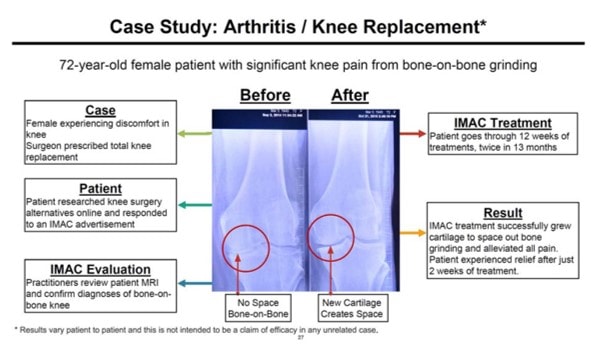
What are we looking at? This is the X-ray of an elderly woman who was told she needs a knee replacement. We don’t know what type of care she received, but given that IMAC is selling shares in a regenerative injection therapy investment, we can likely assume that this is what she had done. The slides claim that this X-ray shows that the woman regained cartilage in her knee. However, as I’ll show you, the slide doesn’t show that at all.
Our eyes are first drawn to the red circle, as it seems to show that there is an increased width in the joint space. The idea here is that if the X-ray shows more width in the joint, then cartilage (which we can’t see on X-rays) would have grown into that space. The problem? An expert can look at this X-ray and see that it’s more sleight of hand than an actual positive result. Let me explain.
Every good magic trick draws your eye away from what’s really going on, and this X-ray is no different. In fact, a magic expert can show you what’s happening over there when you’re looking over here. In this case, while you’re looking at the red circle showing that joint space seems to be increased, where your eye should really be is on the patella (knee cap bone). So let’s compare the knee cap position in the two films:
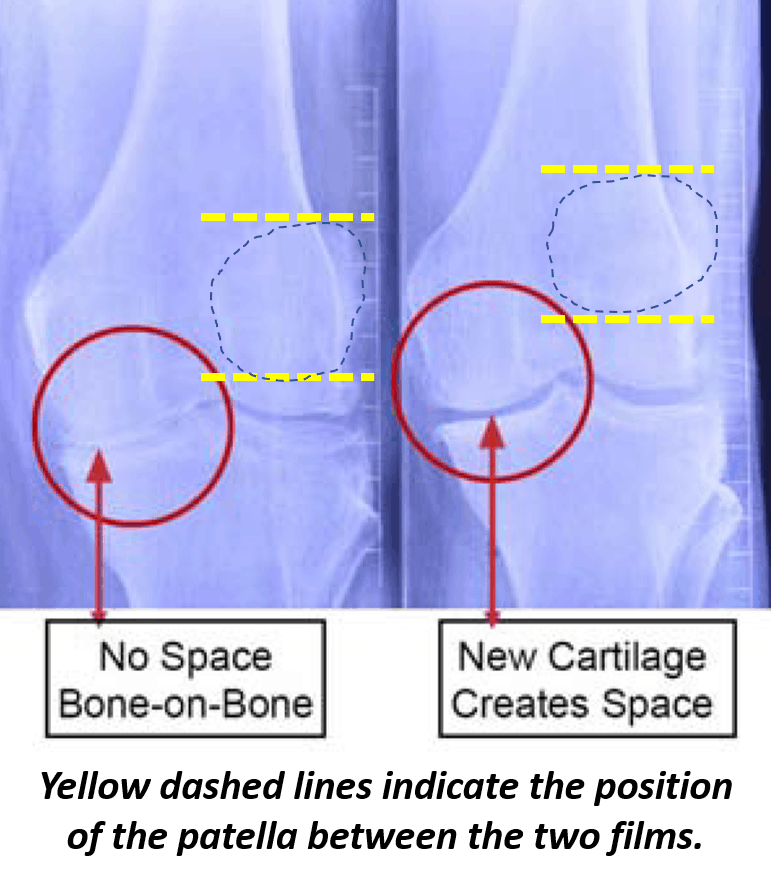
As you can see, I have outlined the kneecap in blue dashed lines and placed yellow dashed lines to indicate the up/down position on the film. You can now see that the kneecap position is very different in these two films. This is all an expert would need to see to know that these films can’t be used to support the idea that cartilage regeneration occurred. Why? To understand that, let’s run through a short tutorial on how knee X-rays work.
First, you need to understand the basic physics of X-rays. Don’t get scared by that term “physics” as I’m going to keep this simple. Consider the X-ray beam here like a flashlight. We all know that if we shine a flashlight on an object that we will see a shadow. That shadow projected onto a wall would move if we move the flashlight relative to the object. The setup is the same here. The flashlight is our X-ray beam, and the wall is the X-ray “film.” Check out my illustration below:
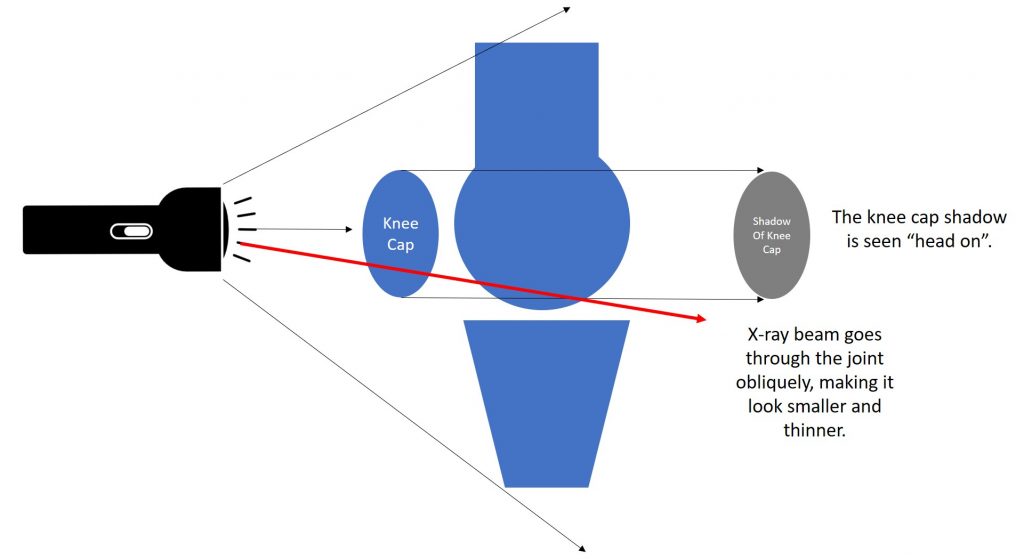
In the illustration above, the flashlight (X-ray beam) sees the kneecap head on, so it casts a shadow of the kneecap in a lower position. That’s just like the “Before” film above. However, note that since the beam is higher, it goes through the joint space of the knee (red line) obliquely. That means that the joint space will look more narrow. Now let’s see what happened on the second or “After” film:
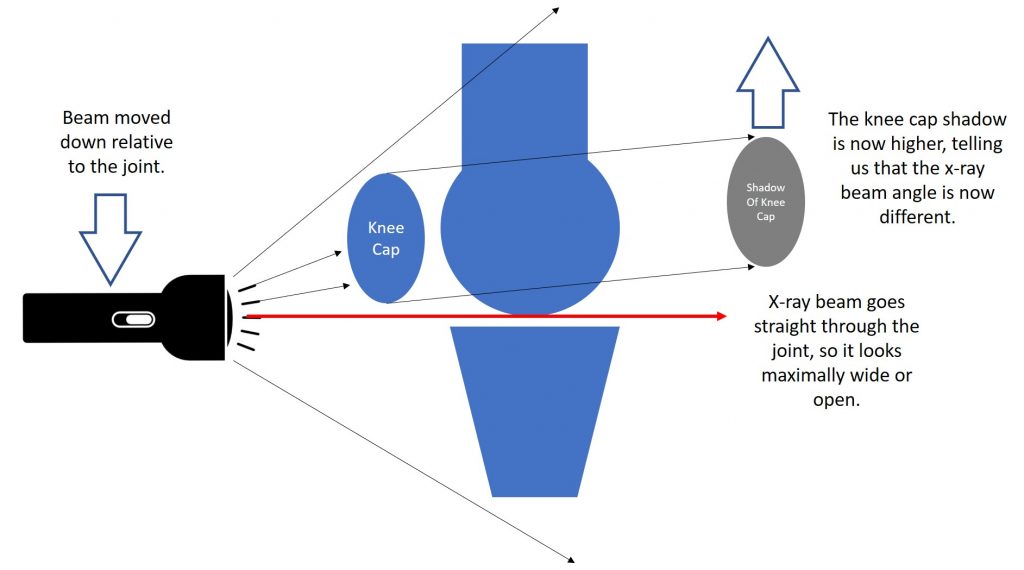
Now the beam has been moved lower relative to the knee. We, therefore, now see the shadow of the kneecap higher, which is exactly like the “After” IMAC film. However, note that now our X-ray beam goes straight through the knee joint, so that will appear wider and more open. So the increased joint width we see in these films is merely a function of adjusting the X-ray beam. Hence, as you can see, the idea that the IMAC films show actual joint space width getting bigger because the cartilage grew is not supported by these films. I did this in my own knee below:
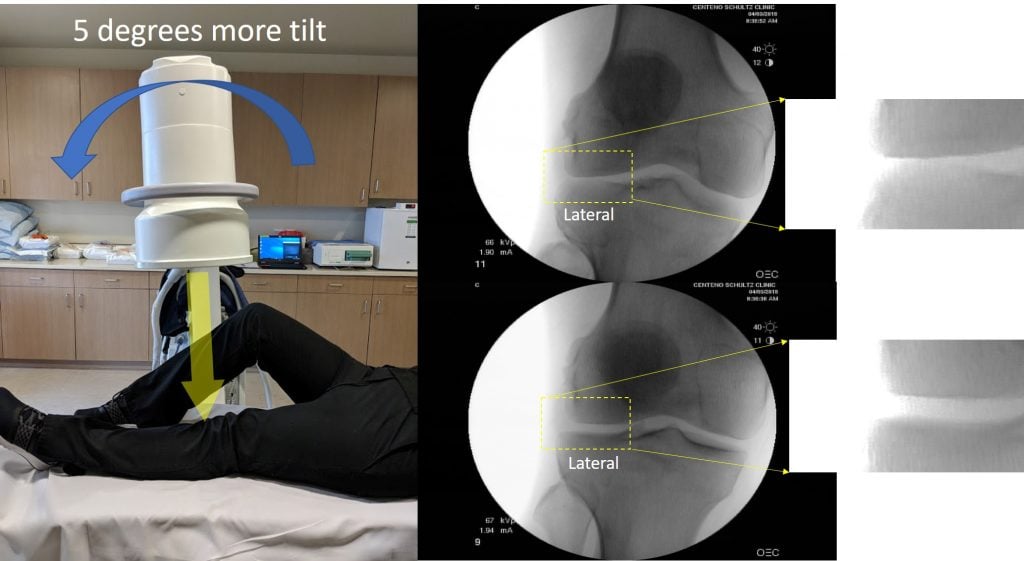
The top film shows what seems to be a joint width decrease, or arthritis. The bottom film was taken seconds later, once I adjusted the beam. In that image, I seem to have regrown loads of new knee cartilage in seconds! Magic? Nope, just physics.
More on the Investment Later
While there is much more to write about this investment slide deck, including the structure of the clinics and the “Neocyte” product that the company will be selling, it takes hours to deep dive into just a few topics. As you can see, just a simple thing like an X-ray and a claim of cartilage regrowth takes a while to explain. Hence, I will have to dive deeper on those issues on another day.
The upshot? My medical deep dive into the IMAC chiropractic stem cell clinic slide deck was not supportive of me spending my money on this investment. My local doctor “test” resulted in confirming my initial thoughts about the clinic chain. In addition, seeing the knee X-ray stem cell hustle in the slide deck was hugely disappointing. Having said that, I’m not an investment expert. So I’ll leave you with that famous quote from Dr. McCoy (Bones) on Star Trek: “Dammit, Jim, I’m a doctor, not a financial planner!” Hence, make up your own mind about this particular investment.
Originally published on

NOTE: This blog post provides general information to help the reader better understand regenerative medicine, musculoskeletal health, and related subjects. All content provided in this blog, website, or any linked materials, including text, graphics, images, patient profiles, outcomes, and information, are not intended and should not be considered or used as a substitute for medical advice, diagnosis, or treatment. Please always consult with a professional and certified healthcare provider to discuss if a treatment is right for you.
